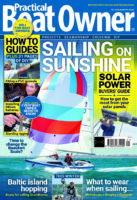Can you protect your boat in UK waters using foul-release coatings, ultrasonic or biomimetic technology? Rob Melotti investigates the antifouling options on the market.
Want to move away from biocide antifouling options, and not sure where to start? PBO investigates.
Copper antifouling has been making boating more efficient for centuries.
From the largest container vessels down to the smallest yacht or powerboat, new ideas have come and gone, leaving this heavy metal as the best, if not the only, biocide in the business.
Yet the technology preventing barnacles, weed and slime from taking root on the underwater hull of your boat may have finally turned a corner, just as the environmental laws restricting the leisure boater’s use of biocides have been getting noticeably tougher.
So, what’s the problem with the status quo? What are these new developments? How do they work? And where can you get them?
The problem
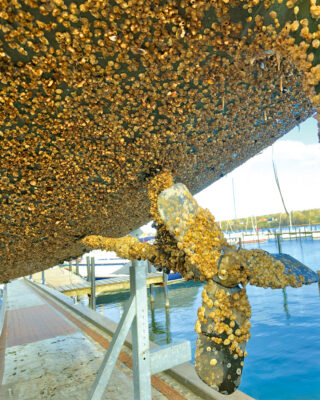
Photo: Sam Fortescue.
Biocide coatings work by poisoning the marine life that attaches itself to the boat, then eroding the coating gradually in order to shed the growth and expose fresh active ingredients to guard against the next wave of settlers.
This eroding, ablating, self-polishing strategy has been dominant in the market for decades, but is under attack on environmental grounds by the Biocidal Products Regulations (BPR).
“We strongly recommend a move away from biocidal coatings as our waters are increasingly polluted,” says Kate Fortnam, RYA sustainability manager. “Copper and zinc are heavy metals and toxic. They act as a poison. Boats do leach these chemicals into the water column, which affects water quality. There is also a risk of higher concentrations where paints are applied or removed without following environmental best practice.”
“Regulations are moving in the right direction,” says Nautix CEO Matthieu Tamburet. “Before BPR, any product could be used. Now, products are limited in type and percentage.”
Nautix, like International Paint, Jotun, Teamac and many other well-known marine coatings brands, only offers biocidal antifouling options for sale in the UK. And to be clear, most UK vessels still use biocide-based antifouling.
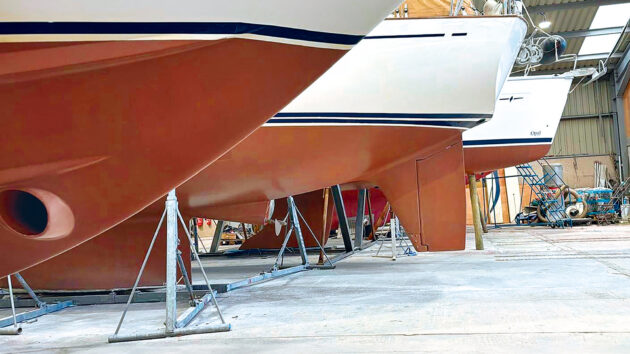
Coppercoat uses a copper-impregnated epoxy to protect against marine growth.
But Tamburet is not alone when he takes issue with the narrative that today’s regulated biocidal products represent a danger to water quality and wildlife.
“The problem is not the copper itself, but its potential overdose. And that’s what the regulations are all about: ensuring that the release is under control, for a given location and a given use.”
“It’s a common misconception that the BPR requires a blanket reduction in copper levels used as the primary biocide,” comments AkzoNobel account manager Ed Warren. “In reality, copper levels in antifouling coatings are subject to environmental assessments; allowable limits vary across regions such as the Atlantic, Baltic, and Mediterranean seas.”
“Some co-biocidal antifouling products are no longer available for retail sale to DIY users. For example, antifoulings containing ‘boosting’ biocides like zinc pyrithione (ZPT) or copper pyrithione (CPT) can no longer be sold directly to consumers. However, professional applicators with appropriate PPE can still purchase and use these products.”
What new antifouling options are on the market?
There are three new options on the market: foul-release formulas, which use silicone instead of biocide; ultrasound technology, which uses electronic pulses to deter marine life from taking root; and ‘biomimetic’ coatings, which attempt to mimic sea-creature skins in order to resist barnacles.
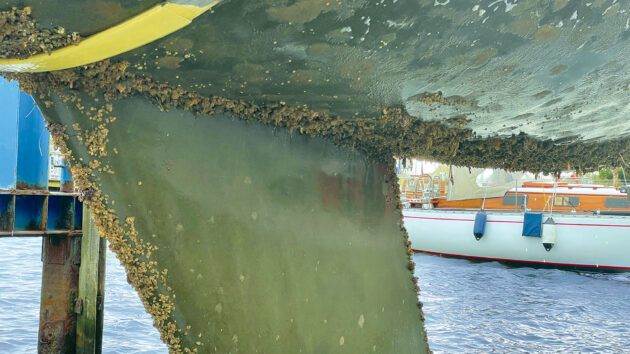
Ultrasonic antifouling is not billed as a replacement for antifouling paint, but rather as a companion that will extend the paint’s life and reduce the fouling. Photo: Sam Fortescue.
Foul-release coatings work by exposing a super-smooth hydrophilic surface to any marine life considering taking up residence – your hull is literally too slippery for anything more complex than slime to actually attach itself.
The technology has been in use since the 1980s on ships and powered vessels that move almost constantly at speeds approaching 10 knots or more, but there has been progress in the market for leisure boaters too.
Hempel Silic One is a DIY applicable silicone coating. Hempel describes the interface between its coating and the seawater as a hydrogel, which is neither water, nor solid. Even vessels that are often stationary still benefit, because although barnacles and algae can ‘settle’ on the hull, as soon as the boat moves, or gets rubbed down with a sprayer or a damp cloth, the fouling is easily dislodged.
Since the launch of Silic One in 2012, there have been incremental additions to the range: Hempaspeed TF can be used on aluminium and steel hulls in fresh and saltwater. It is described as a hard, biocide-free, thin-film coating that may need wiping in high fouling areas throughout the season.
Silic Pro and Hempaguard X7 are aimed at superyachts and combine biocide and silicone technology in the same coating, while Hempasil Pro is a ‘high solids’ coating for all boat types with service speeds above 8 knots. The product can also be used for propellers.
However, the most recent extension of the product is Hempel Infinity, which was launched at the trade fair METS in Amsterdam in November 2024.
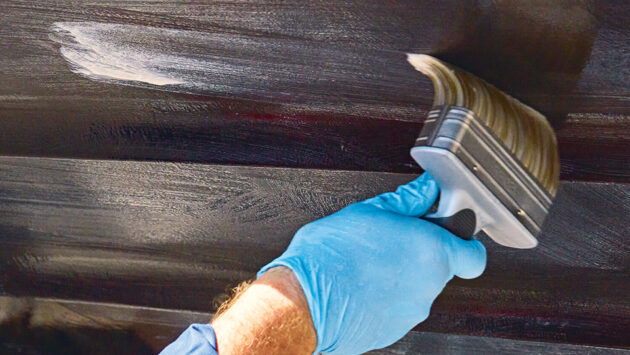
Hempel Infinity renews silicone antifouling paint and requires no sanding, masking or painting. Photo: Hempel.
Infinity is described as a ‘recharger’ for Silic One; it is a transparent, water-based coating that simply extends the life of your boat’s coat of Silic One or Hempasil Pro that is still in good condition. A quick clean with detergent is all the preparation you need; Infinity will add another year to your hydrogel coating, then again the following year, and on and on.
Copper-free antifouling options
Seajet is owned by the Japanese coatings company Chugoku and sells copper-free coatings as well as its Bioclean-Eco (biocide-free) range.
The copper-free products include Seajet Taisho, which uses an alternative biocide called Econea, which is approved for use in Europe currently.
However, the biocide-free range includes Seajet Bioclean Eco, which is a silicone coating that works in a similar manner to Hempel Silic One, using its slipperiness to deter any organisms from taking root on the hull. This is the product that proved so successful on the PBO Project Boat, Maximus.
Seajet 021 Eko is different. Less expensive and less complex than Bioclean Eco, it’s a self-polishing underwater coating that refreshes layer after layer without releasing biocides.
Laurie Brebner, southern area manager at Marine & Industrial, the distributor for Seajet in the UK, describes 021 Eko as “very soft. If you run your fingers over it in the water it feels furry, like soap. But out of the water, it hardens up, again.”
It is rated for boats that can achieve speeds of 40 knots and is an option for new Sunseeker owners (Sunseeker puts Seaject 033 Shogun on its new builds by default). As Brebner points out: “Silicone antifouling is not the easiest thing to apply – overcoating windows are tight, as are drying times – it’s not a straightforward job for a DIY boater.”
International Yacht Paint, which is owned by AkzoNobel, was early to market (in the 1980s) with a foul-release formula called Intersleek for commercial shipping, yet finds itself today in the UK without such a product available for recreational boaters.
In the Netherlands, Germany, Sweden, Finland, Norway and Denmark, however, boat owners can buy and apply B-Free Explore, which is described as a long-lasting biocide-free silicone-polymer coating that needs a tie-coat to seal off any previous antifouling systems.
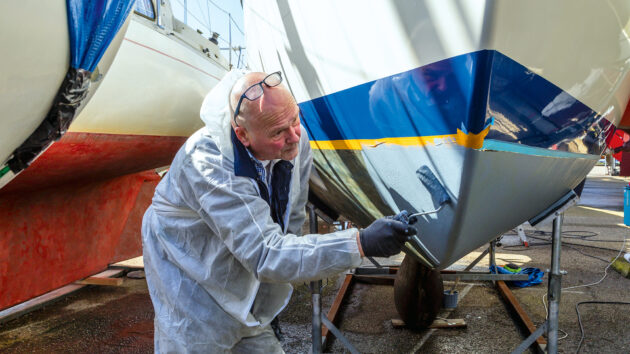
A tie-coat is needed to seal previous antifouling paint or systems before B-Free Explore can be applied. Photo: @zeilen.nl/AkzoNobel.
“In the UK, we didn’t have the same restrictions as other EU markets and therefore we could still sell highly effective biocidal antifouling,” commented Ed Warren.
Ocean Coatings, based in Durham, has brought a brand new formula to market called F2 Eco that claims to be biocide and silicone-free. The problem with silicone is that it is ‘very sensitive to mechanical stress’, according to the F2 Eco website, so there is a new formula at work that guarantees five years but, according to its inventor Keith MacGregor, could well last 10.
Meanwhile, Sea-speed V10 X Ultra, distributed by www.pacoceans.com is a hard silicone (Silane/Siloxane-based) bottom coating. It offers a non-toxic, long-lasting alternative to conventional antifouling paint options, with a lifespan of up to 10 years, and is described as an ideal solution for aluminium boats, composite FRP, gel coat or wooden hull sailboats, powerboats, sportfishing boats, yachts, and sailing vessels.
Ultrasonic action
The ultrasonic antifouling option uses transducers bonded to the interior surface of your boat’s hull that convert high voltages into waves that disrupt all types of marine life attempting to take residence.
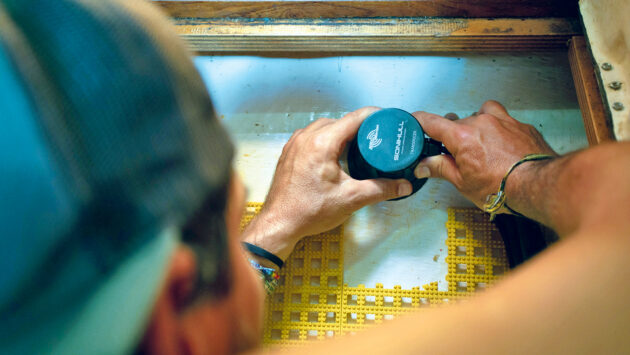
Ultrasonic antifouling emits a low-powered, pulsed ultrasonic frequency from a digital control unit, via transducers in the hull. Photo: Sam Fortescue.
The technology is already well established and proven in the shipping industry, but the transfer to leisure boating has proved challenging.
Sam Fortescue installed it on his yacht in northern Germany – a marine habitat he described as “brackish and nutrient rich” leading to a “riot of sea squirts, weed and barnacles” taking up residence on the underside of his Sadler 34 within days of relaunch, despite its layer of Coppercoat.
He had enjoyed great results with Coppercoat in UK waters and in the Caribbean, so decided against painting over it; instead, he added ultrasonic antifouling to the interior of the hull in the hope of protecting the Coppercoat and working together with it.
He used the Australian system, CleanAHull, and declared his test as ‘overall good – but with caveats’, writing: ‘ultrasonic antifouling isn’t intended to be a replacement for antifouling paint options, but rather as a complementary system.’
In short, it wasn’t a ‘set and forget’ system; his boat still needed regular attention to keep fouling at bay, and once a long period of time was spent stationary, the growth was back in force.
Aquamare, a marine distribution and engineering company with offices in the UK, USA, Australia and France, has been marketing its own EFC (Electronic Fouling Control) system for the past six years. Aqua Sonic comes in six different sizes, based on the power unit you require and the number of transducers.
The Poole-based company Ultrasonic Antifouling Ltd has been in business for a number of years and has launched a new product, UltraSystem Series II. This is claimed to destroy algae completely and prevent weed and barnacle growth, plus it comes with a three-year warranty.
Biomimetic coating antifouling options
This is an area of research and development that is always guaranteed to make good headlines, but to date, it has not generated very much in the way of actual material for use.
Biomimetic means mimicking the methods and materials used in nature, which, in the case of antifouling, means studying how marine creatures such as sharks and sea urchins repel barnacles and algae growth and then attempting to replicate it.
Finsulate is a Dutch product that uses spines, like a sea urchin, to prevent marine growth. A special film with tiny spines is bonded to the boat’s hull, making it virtually impossible for life to take hold.
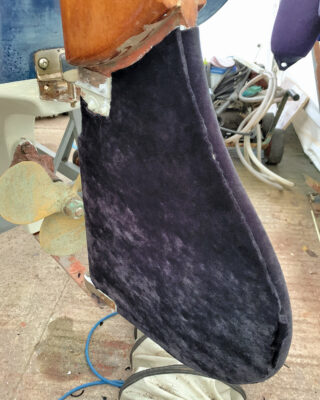
Finsulate is currently being trialled on the Falmouth fast patrol vessel Killigrew and launch Arwenack with the help of technicians at Rustler Yachts. Photo: Falmouth Harbour Commissioners.
Hull preparation involves removing all previous antifouling coatings and applying a single coat of epoxy. Finsulate delivers and applies the product themselves, and then you get an eight-year warranty.
Nippon Paint Marine is a shipping coatings manufacturer that has invested time and money into biomimetic research, highlighting the way super-fast fish like tuna actually secrete a mucus from their skin to reduce friction through the water.
Hydrogel is the technology in use by Hempel, for example, and Nippon has applied products to up to 5,000 ships incorporating the technology too.
Conclusion: the best antifouling options
Change in the industry is slow, but the number of customers for the alternatives to biocide continues to increase.
According to the RYA’s Kate Fortnam: “We encourage and support our members to move away from using ablative products, which are, in the short term, less expensive, and they are also familiar – people know how to apply them annually. There is a hesitancy in trying something new.
We want to be supporting and sharing successes to make boaters confident in trying alternative coatings. The new [foul-release] products also pose some challenges to the infrastructure: lifting boats out; chocking them up in boatyards. How can we start adjusting to new methods of antifouling; to support the transition?”
Antifouling options group test
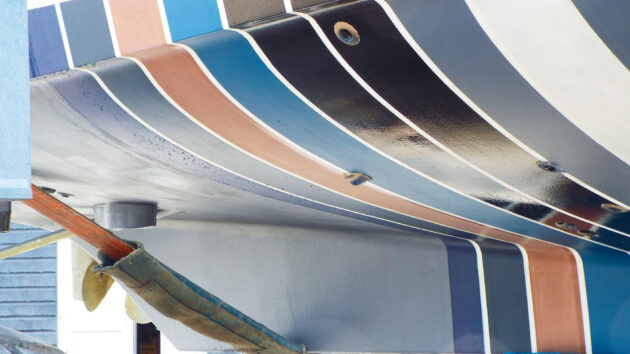
New paint for PBO’s antifouling test.
PBO’s own controlled test carried out in 2021 compared Hempel Silic One and Seajet BioClean Eco against traditional copper antifouling options, resulting in a ‘Best Buy’ verdict for Hempel Silic One and a glowing report for the performance of Seajet Bioclean Eco.
Alison Wood followed up with a test on PBO Project Boat Maximus using Seajet (PBO July 2023), giving excellent results, and most recently (June 2025) Hunter 27 owner Stuart Guy’s DIY application of Hempel Silic One showed the remarkably good results.
On this basis, the overall verdict is that foul-release coatings are not only as good as copper-based self-polishing or ablative coatings… they’re better. Check out the results at www.pbo.co.uk/antifoultest.
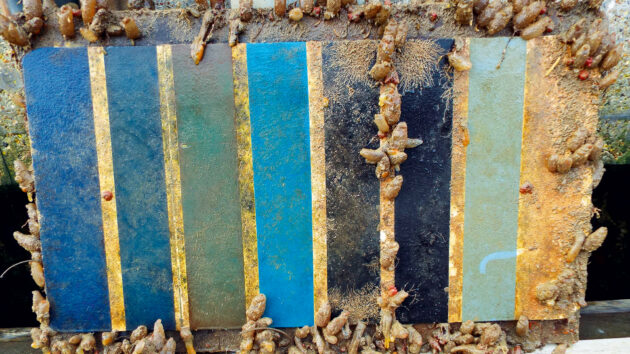
Growth on test boards located in a South Coast marina.
Slippery hulls
What are the disadvantages of slippery silicone hulls?
- The coating is less hard-wearing for dry-stacked vessels, for example, and any damage to the protective layer can let in moisture, creating bubbles and allowing growth to take hold.
- Contamination during application: if the silicone paint gets onto other areas of the boat accidentally, it can be difficult to use other coatings on that area without a full clean-up.
- Lift-out straps and boatyard stands: chocking up slippery hulls is a challenge, and ensuring sling straps are tied together is a sensible precaution when lifting out.
What are the disadvantages of ultrasonic antifouling?
- It’s not a complete system on its own; it’s designed to enhance and assist a hull coating.
- Constant power required and complicated installation.
- Does not work on wooden hulls.
Antifouling: Everything you need to know
Here’s PBO’s guide to preparing for, choosing and using antifouling paints
Seajet Bioclean silicone antifoul review: Our verdict after one year on the water
Does silicone antifouling work? It’s not flying off the shelves yet, according to suppliers, but the results from our Project…
How Hempel’s Silic One silicone antifouling performed over two years on my 27ft boat
Stuart Guy shares the results of how Hempel’s hydro gel fouling-release system has performed on his Hunter Pilot 27 over…
Best antifouling paint: 8 leading options in head-to-head test
In June 2021 we coated the hull of a Hardy Commodore 42 with eight of the best antifouling paint products.…
Want to read more articles like this?
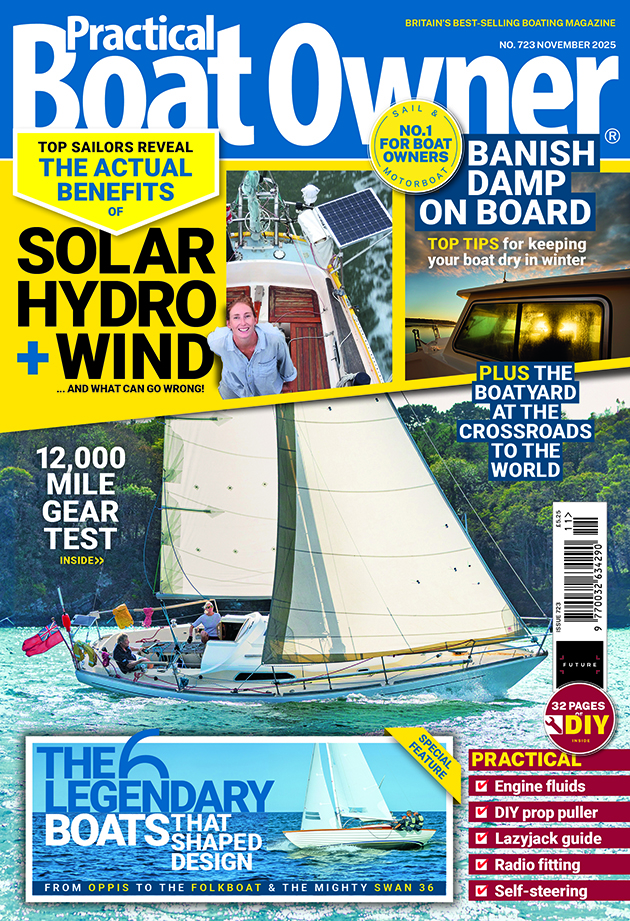
A subscription to Practical Boat Owner magazine costs around 40% less than the cover price.
Print and digital editions are available through Magazines Direct – where you can also find the latest deals.
PBO is packed with information to help you get the most from boat ownership – whether sail or power.
-
-
-
- Take your DIY skills to the next level with trusted advice on boat maintenance and repairs
- Impartial, in-depth gear reviews
- Practical cruising tips for making the most of your time afloat
-
-
Follow us on Facebook, Instagram, TikTok and Twitter

